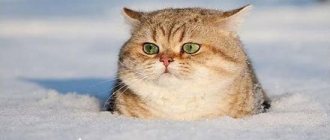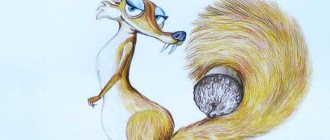Who isn't afraid of frost?
Foxes, hares and wolves practically do not prepare for frosts, as they spend the winter on their feet in search of food. The bunnies just change their clothes: they change their gray fur coat to a white one so that predators do not notice them on the snow carpet. It is very interesting to watch how animals prepare for winter, because everyone has their own secret.
Foxes and wolves
Foxes and wolves do not change the color of their coats, but their fur becomes thicker and fluffier: this makes it easier to survive severe frosts. Wolves gather in packs because it is much more convenient to survive in winter. Sly foxes look for any holes to rest and hide from the snowstorm.
Beavers and squirrels
Squirrels and beavers do not hibernate, but they are trained responsibly. Beavers live in large families, all together they build cozy houses near ponds, next to which they put their food - twigs from trees. They also feed on the roots of plants that grow in water.
I wonder how a squirrel prepares for winter? Red-haired forest dwellers do not hibernate, although they spend most of their time in their homes - hollows that they build high in the trees.
This rodent changes the color of its coat from red to grayish to camouflage itself from predators. What does a squirrel eat in winter? During the cold season, this rodent stocks up with the following belongings:
- acorns,
- mushrooms,
- nuts,
- seeds.
Let's talk about the bear
Bears set up their home in advance. They look for caves, ditches, where they carry leaves, branches, moss, and make a soft mattress on top from spruce branches. When snow falls, it masks the bear's hiding place and keeps it warm.
Bears do not store food, but in the fall they actively feed on nuts and fish in order to accumulate as much fat as possible for the winter. In fact, the predator does not sleep, but dozes, and if necessary, it can leave the den. It is in winter that a mother bear gives birth to small cubs.
This is how animals spend the winter. Some sleep all winter, others try to stay warm and find food for themselves. And here you can learn a lot more interesting things about animals, birds and insects.
Read also:
- Birds wintering in Ukraine.
- Preparing insects for winter.
How does a hedgehog prepare for winter?
For some of our wild animals, being well prepared for winter is a matter of survival.
Because hedgehogs are nocturnal, we sometimes don't notice them scurrying around our garden, helping us fight off slugs, snails and even insects that damage the plants we carefully cultivate.
As winter approaches, hedgehogs begin to prepare for hibernation. Hibernating animals slow their heartbeat and breathing rate, lower their body temperature and lower their metabolism to conserve energy, so having a good supply of fat and a stable sheltering environment is vital.
Hedgehogs typically hibernate from October to March and need to rely on their fat reserves to survive until spring. However, there could be many reasons why your hedgehog may not have gained enough weight. For example, bad weather can be a reason. Or young age, i.e. the animal did not live long enough to gain sufficient weight.
So, as hibernation season approaches, it can't hurt to give your hedgehogs a helping hand when it comes to finding food. You can leave food in the garden; meat food for cats and dogs (without fishy taste), seeds, nuts, and cottage cheese are suitable. You can also find special food for hedgehogs in stores. However, under no circumstances should you feed your hedgehog bread or milk, as they do not digest such food well.
If you are lucky enough to have a hedgehog in your garden, one important thing you can do is make him his own little house! The sooner you place such a house in your garden, the more likely it is that you will have a new neighbor. Place the house in a quiet place and cover it with dry branches, leaves and sticks. If you suspect a hedgehog is sleeping in your garden, be careful not to disturb it.
How does a hare prepare for winter?
Hares do not hibernate, but a number of behavioral and physiological adaptations help them survive the winter. They have thick fur and a low surface area to volume ratio, which retains body heat. Hares sometimes dig shelters in the snow and huddle together to keep each other warm.
The main preparation of hares for winter is their ability to change their coat twice a year for better camouflage. In the fall, their thin brown fur gradually turns into a thicker white fur, giving them the ability to camouflage themselves against both summer and winter backgrounds. In spring, the fur turns brown again in response to increasing daylight hours.
To protect themselves when they sense danger, young hares usually remain motionless to blend into the surrounding background, but the usual strategy of adults is to run away and confuse the predator by rushing in different directions. Adult hares can cover a distance of up to three meters in one jump and reach speeds of up to 45 kilometers per hour.








